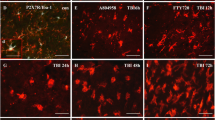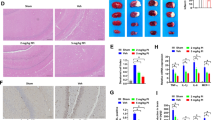Abstract
Tetrahydrocurcumin (THC) and microglial polarization play crucial roles in neuroprotection during traumatic brain injury (TBI). However, whether THC regulates microglial polarization in TBI is unknown. Thus, we intended to analyze the functions and mechanism of THC in nerve injury after TBI via the regulation of microglial polarization. A TBI rat model was established, and modified neurological function score (mNSS), brain water content, Nissl staining, and Fluoro-Jade B (FJB) staining were used to evaluate neurological function. The expression of the M1-linked markers CD16 and CD86, as well as the M2-associated markers CD206 and YM-1, was analyzed via qRT–PCR, western blotting, and immunofluorescence. The levels of inflammatory cytokines were assessed via ELISA. Primary microglia were isolated from the brain and treated with lipopolysaccharide (LPS) to induce injury. TUNEL staining was used to measure primary microglial apoptosis. The expression of GSK3β, PTEN, and PI3K/Akt pathway proteins was detected via western blotting. TBI induced nerve injury, while THC improved neurological function recovery after TBI. Further analysis indicated that THC enhanced M2 microglial polarization and attenuated the inflammatory reaction mediated by microglia both in vitro and in vivo. Moreover, we found that THC promoted the M2 microglial phenotype through upregulating GSK3β expression. Additionally, we proved that GSK3β activated the PI3K/Akt pathway by phosphorylating PTEN. In conclusion, we demonstrated that THC protected against nerve injury after TBI via microglial polarization via the GSK3B/PTEN/PI3K/Akt signaling axis, suggesting the potential of THC for TBI treatment by promoting microglial M2 polarization.





Similar content being viewed by others
Data Availability
The original data included in this study are available from the corresponding author upon reasonable request.
References
Capizzi A, Woo J, Verduzco-Gutierrez M (2020) Traumatic brain injury: an overview of epidemiology, pathophysiology, and medical management. Med Clin North Am 104(2):213–238. https://doi.org/10.1016/j.mcna.2019.11.001
Khellaf A, Khan DZ, Helmy A (2019) Recent advances in traumatic brain injury. J Neurol 266(11):2878–2889. https://doi.org/10.1007/s00415-019-09541-4
Galgano M, Toshkezi G, Qiu X, Russell T, Chin L, Zhao LR (2017) Traumatic brain injury: current treatment strategies and future endeavors. Cell Transplant 26(7):1118–1130. https://doi.org/10.1177/0963689717714102
Chen Z, Trapp BD (2016) Microglia and neuroprotection. J Neurochem 136(Suppl 1):10–17. https://doi.org/10.1111/jnc.13062
Coomey R, Stowell R, Majewska A, Tropea D (2020) The role of microglia in neurodevelopmental disorders and their therapeutics. Curr Top Med Chem 20(4):272–276. https://doi.org/10.2174/1568026620666200221172619
Yang X, Xu S, Qian Y, Xiao Q (2017) Resveratrol regulates microglia M1/M2 polarization via PGC-1alpha in conditions of neuroinflammatory injury. Brain Behav Immun 64:162–172. https://doi.org/10.1016/j.bbi.2017.03.003
Song Y, Li Z, He T, Qu M, Jiang L, Li W, Shi X, Pan J, Zhang L, Wang Y, Zhang Z, Tang Y, Yang GY (2019) M2 microglia-derived exosomes protect the mouse brain from ischemia-reperfusion injury via exosomal miR-124. Theranostics 9(10):2910–2923. https://doi.org/10.7150/thno.30879
Witcher KG, Bray CE, Dziabis JE, McKim DB, Benner BN, Rowe RK, Kokiko-Cochran ON, Popovich PG, Lifshitz J, Eiferman DS, Godbout JP (2018) Traumatic brain injury-induced neuronal damage in the somatosensory cortex causes formation of rod-shaped microglia that promote astrogliosis and persistent neuroinflammation. Glia 66(12):2719–2736. https://doi.org/10.1002/glia.23523
Long X, Yao X, Jiang Q, Yang Y, He X, Tian W, Zhao K, Zhang H (2020) Astrocyte-derived exosomes enriched with miR-873a-5p inhibit neuroinflammation via microglia phenotype modulation after traumatic brain injury. J Neuroinflammation 17(1):89. https://doi.org/10.1186/s12974-020-01761-0
Wu JC, Tsai ML, Lai CS, Wang YJ, Ho CT, Pan MH (2014) Chemopreventative effects of tetrahydrocurcumin on human diseases. Food Funct 5(1):12–17. https://doi.org/10.1039/c3fo60370a
Li K, Zhai M, Jiang L, Song F, Zhang B, Li J, Li H, Li B, Xia L, Xu L, Cao Y, He M, Zhu H, Zhang L, Liang H, Jin Z, Duan W, Wang S (2019) Tetrahydrocurcumin ameliorates diabetic cardiomyopathy by attenuating high glucose-induced oxidative stress and fibrosis via activating the SIRT1 pathway. Oxid Med Cell Longev 2019:6746907. https://doi.org/10.1155/2019/6746907
Pan Y, Zhang Y, Yuan J, Ma X, Zhao Y, Li Y, Li F, Gong X, Zhao J, Tang H, Wang J (2020) Tetrahydrocurcumin mitigates acute hypobaric hypoxia-induced cerebral oedema and inflammation through the NF-kappaB/VEGF/MMP-9 pathway. Phytother Res 34(11):2963–2977. https://doi.org/10.1002/ptr.6724
Mishra S, Mishra M, Seth P, Sharma SK (2011) Tetrahydrocurcumin confers protection against amyloid beta-induced toxicity. Neuroreport 22(1):23–27. https://doi.org/10.1097/WNR.0b013e328341e141
Tyagi N, Qipshidze N, Munjal C, Vacek JC, Metreveli N, Givvimani S, Tyagi SC (2012) Tetrahydrocurcumin ameliorates homocysteinylated cytochrome-c mediated autophagy in hyperhomocysteinemia mice after cerebral ischemia. J Mol Neurosci 47(1):128–138. https://doi.org/10.1007/s12031-011-9695-z
Gao Y, Li J, Wu L, Zhou C, Wang Q, Li X, Zhou M, Wang H (2016) Tetrahydrocurcumin provides neuroprotection in rats after traumatic brain injury: autophagy and the PI3K/AKT pathways as a potential mechanism. J Surg Res 206(1):67–76. https://doi.org/10.1016/j.jss.2016.07.014
Yang Y, Ye Y, Kong C, Su X, Zhang X, Bai W, He X (2019) MiR-124 enriched exosomes promoted the M2 polarization of microglia and enhanced hippocampus neurogenesis after traumatic brain injury by inhibiting TLR4 pathway. Neurochem Res 44(4):811–828. https://doi.org/10.1007/s11064-018-02714-z
Cai L, Gong Q, Qi L, Xu T, Suo Q, Li X, Wang W, Jing Y, Yang D, Xu Z, Yuan F, Tang Y, Yang G, Ding J, Chen H, Tian H (2022) ACT001 attenuates microglia-mediated neuroinflammation after traumatic brain injury via inhibiting AKT/NFκB/NLRP3 pathway. Cell Commun Signal 20(1):56. https://doi.org/10.1186/s12964-022-00862-y
Mustafa AG, Alshboul OA (2013) Pathophysiology of traumatic brain injury. Neurosciences 18(3):222–234
Najem D, Rennie K, Ribecco-Lutkiewicz M, Ly D, Haukenfrers J, Liu Q, Nzau M, Fraser DD, Bani-Yaghoub M (2018) Traumatic brain injury: classification, models, and markers. Biochem Cell Biol 96(4):391–406. https://doi.org/10.1139/bcb-2016-0160
Nayak D, Roth TL, McGavern DB (2014) Microglia development and function. Annu Rev Immunol 32:367–402. https://doi.org/10.1146/annurev-immunol-032713-120240
Stohs SJ, Chen O, Ray SD, Ji J, Bucci LR, Preuss HG (2020) Highly bioavailable forms of curcumin and promising avenues for curcumin-based research and application: a review. Molecules 25(6). https://doi.org/10.3390/molecules25061397
Xi J, Luo X, Wang Y, Li J, Guo L, Wu G, Li Q (2019) Tetrahydrocurcumin protects against spinal cord injury and inhibits the oxidative stress response by regulating FOXO4 in model rats. Exp Ther Med 18(5):3681–3687. https://doi.org/10.3892/etm.2019.7974
Gao Y, Zhuang Z, Gao S, Li X, Zhang Z, Ye Z, Li L, Tang C, Zhou M, Han X, Li J (2017) Tetrahydrocurcumin reduces oxidative stress-induced apoptosis via the mitochondrial apoptotic pathway by modulating autophagy in rats after traumatic brain injury. Am J Transl Res 9(3):887–899
Wei G, Chen B, Lin Q, Li Y, Luo L, He H, Fu H (2017) Tetrahydrocurcumin provides neuroprotection in experimental traumatic brain injury and the Nrf2 signaling pathway as a potential mechanism. Neuroimmunomodulation 24(6):348–355. https://doi.org/10.1159/000487998
Wolf SA, Boddeke HW, Kettenmann H (2017) Microglia in physiology and disease. Annu Rev Physiol 79:619–643. https://doi.org/10.1146/annurev-physiol-022516-034406
Colonna M, Butovsky O (2017) Microglia function in the central nervous system during health and neurodegeneration. Annu Rev Immunol 35:441–468. https://doi.org/10.1146/annurev-immunol-051116-052358
Wang J, Hou Y, Zhang L, Liu M, Zhao J, Zhang Z, Ma Y, Hou W (2021) Estrogen attenuates traumatic brain injury by inhibiting the activation of microglia and astrocyte-mediated neuroinflammatory responses. Mol Neurobiol 58(3):1052–1061. https://doi.org/10.1007/s12035-020-02171-2
Wu H, Zheng J, Xu S, Fang Y, Wu Y, Zeng J, Shao A, Shi L, Lu J, Mei S, Wang X, Guo X, Wang Y, Zhao Z, Zhang J (2021) Mer regulates microglial/macrophage M1/M2 polarization and alleviates neuroinflammation following traumatic brain injury. J Neuroinflammation 18(1):2. https://doi.org/10.1186/s12974-020-02041-7
Xiao Y, Dai Y, Li L, Geng F, Xu Y, Wang J, Wang S, Zhao J (2021) Tetrahydrocurcumin ameliorates Alzheimer’s pathological phenotypes by inhibition of microglial cell cycle arrest and apoptosis via Ras/ERK signaling. Biomed Pharmacother 139:111651. https://doi.org/10.1016/j.biopha.2021.111651
Fortress AM, Avcu P, Wagner AK, Dixon CE, Pang KCH (2019) Experimental traumatic brain injury results in estrous cycle disruption, neurobehavioral deficits, and impaired GSK3beta/beta-catenin signaling in female rats. Exp Neurol 315:42–51. https://doi.org/10.1016/j.expneurol.2019.01.017
Zhang B, Li Z, Zhang R, Hu Y, Jiang Y, Cao T, Wang J, Gong L, Ji L, Mu H, Yang X, Dai Y, Jiang C, Yin Y, Zou J (2019) PKCgamma promotes axonal remodeling in the cortico-spinal tract via GSK3beta/beta-catenin signaling after traumatic brain injury. Sci Rep 9(1):17078. https://doi.org/10.1038/s41598-019-53225-y
Cao Q, Karthikeyan A, Dheen ST, Kaur C, Ling EA (2017) Production of proinflammatory mediators in activated microglia is synergistically regulated by Notch-1, glycogen synthase kinase (GSK-3beta) and NF-kappaB/p65 signalling. PLoS One 12(10):e0186764. https://doi.org/10.1371/journal.pone.0186764
Zhou K, Zhong Q, Wang YC, Xiong XY, Meng ZY, Zhao T, Zhu WY, Liao MF, Wu LR, Yang YR, Liu J, Duan CM, Li J, Gong QW, Liu L, Yang MH, Xiong A, Wang J, Yang QW (2017) Regulatory T cells ameliorate intracerebral hemorrhage-induced inflammatory injury by modulating microglia/macrophage polarization through the IL-10/GSK3beta/PTEN axis. J Cereb Blood Flow Metab 37(3):967–979. https://doi.org/10.1177/0271678X16648712
Kitagishi Y, Matsuda S (2013) Diets involved in PPAR and PI3K/AKT/PTEN pathway may contribute to neuroprotection in a traumatic brain injury. Alzheimers Res Ther 5(5):42. https://doi.org/10.1186/alzrt208
Xu L, Xing Q, Huang T, Zhou J, Liu T, Cui Y, Cheng T, Wang Y, Zhou X, Yang B, Yang GL, Zhang J, Zang X, Ma S, Guan F (2018) HDAC1 Silence promotes neuroprotective effects of human umbilical cord-derived mesenchymal stem cells in a mouse model of traumatic brain injury via PI3K/AKT pathway. Front Cell Neurosci 12:498. https://doi.org/10.3389/fncel.2018.00498
Wang G, Shi Y, Jiang X, Leak RK, Hu X, Wu Y, Pu H, Li WW, Tang B, Wang Y, Gao Y, Zheng P, Bennett MV, Chen J (2015) HDAC inhibition prevents white matter injury by modulating microglia/macrophage polarization through the GSK3beta/PTEN/Akt axis. Proc Natl Acad Sci U S A 112(9):2853–2858. https://doi.org/10.1073/pnas.1501441112
Wang Y, Wang L, Hu T, Wang F, Han Z, Yin Z, Ge X, Xie K, Lei P (2020) Hydrogen improves cell viability partly through inhibition of autophagy and activation of PI3K/Akt/GSK3beta signal pathway in a microvascular endothelial cell model of traumatic brain injury. Neurol Res 42(6):487–496. https://doi.org/10.1080/01616412.2020.1747717
Funding
This work was supported by the Natural Science Foundation of Jiangsu Province (BK20221091), the General Program of China Postdoctoral Science Foundation (2022M711369), the Natural Science Foundation of the Anhui Education Department (No. KJ2021A0239), the Suzhou Science and Technology Council (SNG201907), and the Natural Science Research Project of Universities in Jiangsu Province (20KJB330002).
Author information
Authors and Affiliations
Contributions
Tushuai Li and Jie Zhang conceived and designed the experiments. Tushuai Li helped with the animal experiments. Tushuai Li and Yue Gu performed the data analyses. Yue Gu and Lisha Yu helped perform the analysis and provided constructive discussions. Jie Zhang wrote the draft manuscript. Tushuai Li and Jie Zhang revised the manuscript.
Corresponding author
Ethics declarations
Ethics Approval
All animal experiments were approved by the Jiangnan University Experimental Animal Ethics Committee and were conducted under strict supervision.
Conflict of Interest
The authors declare no competing interests.
Additional information
Publisher’s Note
Springer Nature remains neutral with regard to jurisdictional claims in published maps and institutional affiliations.
Rights and permissions
Springer Nature or its licensor (e.g. a society or other partner) holds exclusive rights to this article under a publishing agreement with the author(s) or other rightsholder(s); author self-archiving of the accepted manuscript version of this article is solely governed by the terms of such publishing agreement and applicable law.
About this article
Cite this article
Zhang, J., Gu, Y., Sun, W. et al. Tetrahydrocurcumin Protects Against GSK3β/PTEN/PI3K/Akt-Mediated Neuroinflammatory Responses and Microglial Polarization Following Traumatic Brain Injury. Mol Neurobiol (2024). https://doi.org/10.1007/s12035-024-04034-6
Received:
Accepted:
Published:
DOI: https://doi.org/10.1007/s12035-024-04034-6




